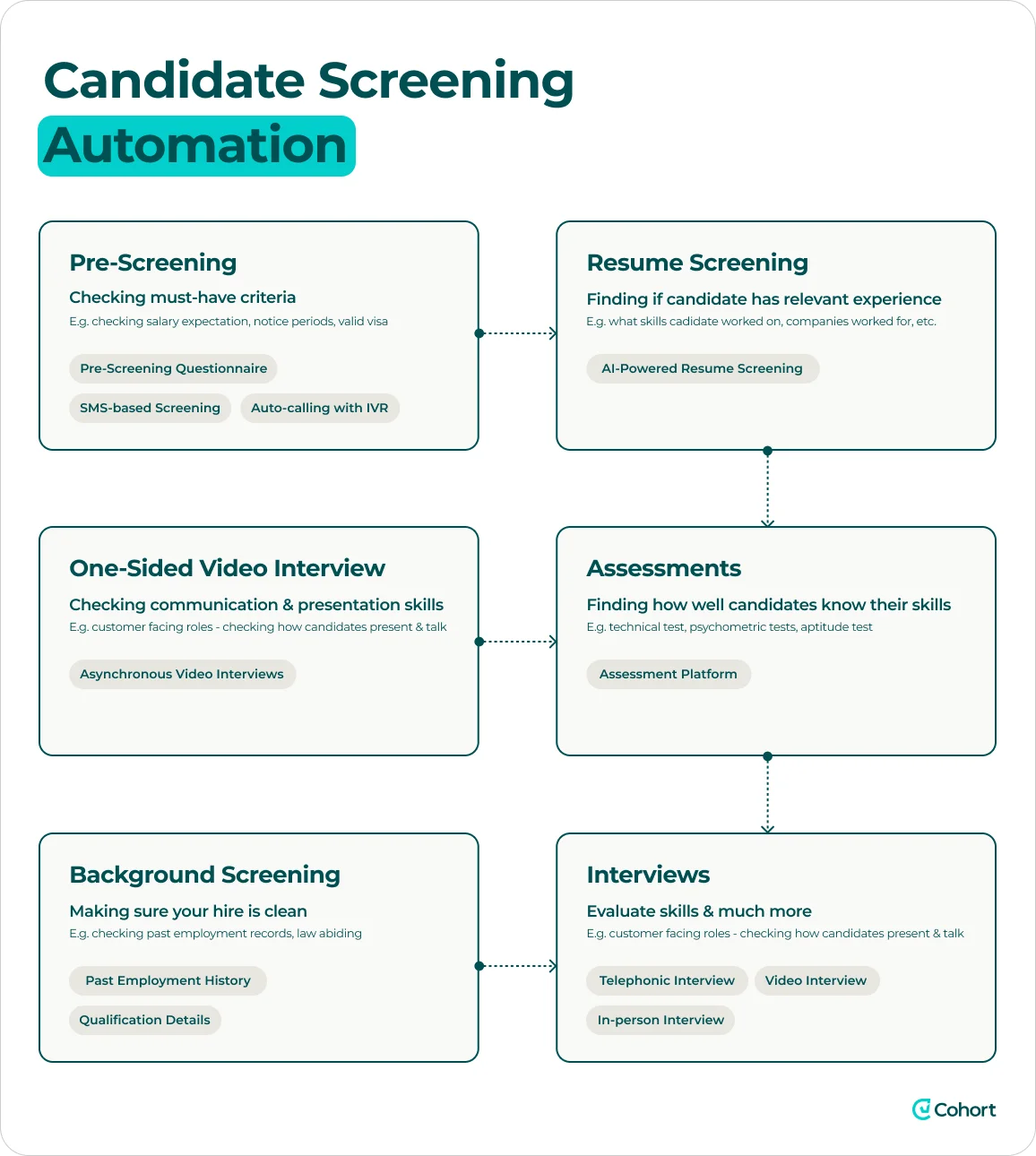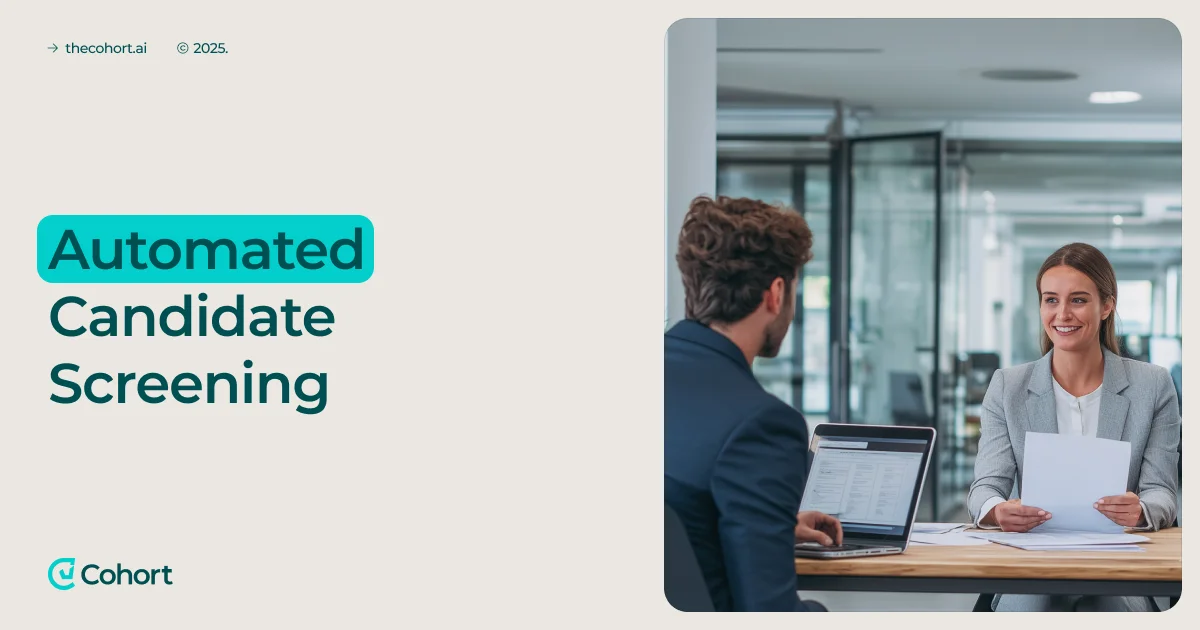Are you spending hours skimming through resumes only to feel overwhelmed by the sheer volume of applications?
Many recruiters face the same challenge, which is why adopting automated candidate screening has become essential for efficiently and fairly managing applications.
In this guide, we’ll break down how automated candidate screening works, why it matters in 2025, and how it can help you shortlist the right candidates with speed and confidence.
Let’s get started!
Key takeaways
- AI screening cuts recruiters' time by nearly 70%
Automated tools can scan thousands of resumes in minutes and consistently rank candidates. This lets recruiters focus on interviews and building relationships instead of manual sorting.
- Context-aware tools improve candidate quality.
Modern AI reads resumes in context, recognizing synonyms and skill adjacencies. This ensures strong candidates aren’t overlooked just because of wording differences.
- Faster and fairer hiring wins top talent.
AI reduces unconscious bias by applying the same rules to everyone and can cut hiring cycles by up to 60%. This helps companies secure top candidates before competitors do.
- Automation enhances candidate experience.
Instant updates and chatbots prevent applications from disappearing into a “black hole.” When balanced with human interaction, this creates a smoother and more positive candidate experience.
- Cohort AI simplifies the entire process.
Our platform goes beyond resume scanning to rank, engage, and nurture candidates. It delivers trusted shortlists and prevents drop-offs, making hiring faster and smarter.
What is automated candidate screening?
Automated candidate screening utilizes software, algorithms, and artificial intelligence (AI) to evaluate job applications and filter candidates efficiently.
Instead of recruiters manually reading every resume, an Applicant Tracking System (ATS) scans resumes and applications against set criteria to decide who moves forward.

However, modern AI recruitment tools go even further, offering context-aware screening, candidate ranking, automated scheduling, and personalized communication.
Here’s a snapshot of old vs. new screening methods:
In practice, this technology functions as a fast and intelligent filter, selecting the most qualified applicants from a large pool.
Recruiters save time on repetitive resume reviews, allowing them to focus on higher-value tasks, such as interviewing, candidate engagement, and relationship building.
How automated candidate screening works in modern hiring
Automated screening now plays a central role from the moment a candidate applies.
Instead of recruiters spending hours on manual resume checks, AI tools step in to organize, analyze, and consistently rank applicants.
To put this into perspective, modern platforms go far beyond basic keyword searches.
With natural language processing (NLP) and large language models (LLMs), they interpret resumes in context.
For example, a phrase like ‘led a team of 5 engineers to build a mobile app’ is recognized as proof of both leadership and technical expertise, even if the word ‘manager’ never appears.
These systems also understand synonyms and related terms, knowing that ‘B.S.’ refers to a Bachelor’s degree or that ‘Google Analytics’ experience connects directly to digital marketing skills.
Here’s how the whole process typically unfolds:
1. Parsing resumes
The system’s first task is to break down raw applications into usable data.
This ensures all resumes can be compared on the same terms:
- Extracts details such as name, contact information, work experience, education, and skills.
- Converts everything into a standard format for consistency.
2. Matching against requirements
Once data is structured, the platform measures each profile against the job description.
Recruiters define both essential and preferred criteria:
- Must-have qualifications (e.g. certifications, years of experience).
- Nice-to-have skills or additional preferences.
💡 Pro tip
Cohort AI utilizes advanced matching to pinpoint only candidates who precisely meet your exact requirements.
Its precision ensures you get the right talent faster without sorting through irrelevant profiles.
3. Multi-stage screening
Screening extends beyond resumes, adding extra layers of evaluation.
Automation tools interact with candidates and assess their skills automatically:
- Chatbots ask knockout questions (e.g., availability, work authorization).
- Skill tests or one-way video interviews are analyzed and added to the profile.
4. Shortlisting
After processing all inputs, the system delivers a refined shortlist of top candidates.
This helps recruiters focus on the best matches quickly:
- Ranks candidates by match score and relevance.
- Provides a consistent, time-saving first-round filter.
💡 Pro tip
Cohort’s Eva the Evaluator AI agent runs async, role-specific interviews and scores responses based on fit signals you define.
You replace hours of first-round calls with fast, fair assessments.
Why automated candidate screening matters in 2025?
1. The rise of AI-driven recruitment technology
Recruitment has entered an AI-driven era, and the technology itself has matured rapidly.
Today’s platforms use predictive algorithms and even generative AI to:
- Draft job descriptions,
- Personalize candidate communication,
- Provide predictive candidate scoring,
- Power chatbots for real-time engagement.
The truth is that AI has evolved into a sophisticated partner in hiring, accessible even to small HR teams, and the numbers show how mainstream it has become:
- By the end of 2025, AI is expected to handle 95% of initial candidate screenings.
- 87% of companies already use AI-powered software to improve hiring efficiency.
- 67% of talent acquisition professionals say AI and automation have significantly improved hiring processes.
- Nearly 8 in 10 companies have integrated AI or automation into their ATS.
- 64% of recruiters rely on AI to filter out unqualified candidates.
2. Growing need for faster and fairer hiring
Speed and fairness have become critical in recruitment.
Top candidates are snapped up quickly, and companies that move too slowly risk losing out.
At the same time, organizations are under pressure to develop fairer and transparent hiring processes.
Why speed matters in 2025:
- Top candidates are available for an average of 10 days before being hired by another company.
- Automated screening can reduce the hiring cycle by up to 60%.
- 89% of recruiters say AI helps them save time.
Why fairness matters in 2025:
- AI applies the same criteria to all applicants, minimizing unconscious bias.
- Resume anonymization can conceal names, gender, or other personal identifiers, focusing solely on skills and experience.
- Research shows AI screening can cut unconscious bias by up to 40% when properly implemented.
In short, AI-driven screening offers recruiters the dual advantage of speed and fairness.
Additionally, it enables them to reach strong candidates more quickly while creating a process that’s consistent, auditable, and equitable.
💡 Pro tip
AI streamlines the screening process, while human oversight in Cohort AI prevents model drift and continuously checks for algorithmic bias.
3. Impact on candidate experience and employer branding
Hiring is a two-way street.
Candidates judge the company just as much as the company judges them.
A slow or unclear process can damage employer branding, while a smooth experience can set a company apart.
How automation improves candidate experience:
- AI chatbots and automated emails prevent the “application black hole” by instantly acknowledging applications.
- Real-time updates keep candidates informed about their status and next steps
- Companies using AI chatbots (like IBM’s Watson Candidate Assistant) report higher satisfaction because candidates feel valued.
Why speed matters for experience:
- In 2025, 66% of candidates said that an efficient hiring process influenced their decision to accept an offer.
- Over 25% of job seekers declined offers in 2024 due to delays or poor communication.
- Automation allows faster shortlisting and interview scheduling, reducing idle time for applicants.
Balancing automation with a human touch:
- 47% of job seekers say AI chatbots alone feel too impersonal.
- The best companies combine automation for efficiency with targeted interactions from recruiters at key stages.
- By freeing recruiters from administrative tasks, automation allows them to spend more time building genuine candidate relationships.
This demonstrates that when executed effectively, automated screening not only accelerates the hiring process but also enhances an employer's brand.
💡 Pro tip:
Cohort’s Charlie the Closer AI agent handles candidate nudging, Q&A, and post-interview engagement automatically.
It prevents drop-offs and builds trust across every touchpoint.
Key benefits of automated candidate screening
Automated screening brings several clear advantages that make hiring faster, smarter, and more consistent:
- Saves time: AI can scan thousands of resumes in minutes. With 43% of recruiters citing time savings as the top benefit, AI can significantly streamline the hiring process.
- Improves quality of hire: Predictive analytics rank candidates by likelihood of success, making companies 46% more likely to secure high-performing hires.
- Reduces bias: Automated screening applies the same criteria to everyone and supports blind reviews, reducing unconscious bias in hiring by up to 40%.
- Scales hiring: Handles hundreds or even millions of applications with consistent standards, as demonstrated by Walmart's use of AI to manage mass recruitment.
- Supports compliance: Creates audit trails, enforces fair evaluation, and helps meet regulations such as GDPR, EEO, and new bias audit laws.
Best practices for using automated candidate screening
1. Define clear job requirements and criteria
Clear requirements are the foundation of effective automated screening.
Without them, even the best AI will produce weak results.
Defining must-have qualifications and nice-to-have skills upfront ensures your system evaluates candidates against meaningful, job-related criteria.
🧠 Why is this essential?
Vague criteria like “solid experience” leave too much room for interpretation and bias.
Precise, objective rules improve both fairness and candidate quality.
🚀 How it’s done:
- Translate job descriptions into measurable requirements (e.g., “3+ years in X software”).
- Mark some criteria as mandatory and others as preferred in your ATS.
- Involve hiring managers and top performers when setting benchmarks.
✅ Extra insight:
Companies that use contextual resume screening with well-defined parameters report higher-quality shortlists and fewer mismatches.
2. Regularly audit and update AI algorithms
Automated screening is not a set-and-forget tool.
Over time, job requirements change, and AI models may drift or develop unintended patterns.
Regular audits help ensure your system stays accurate and fair.
🧠 Why is this essential?
Unchecked algorithms may reinforce bias or prioritize outdated skills, resulting in weaker hires and increased compliance risks.
🚀 How it’s done:
- Review demographic breakdowns of screened vs. rejected candidates.
- Track quality of hire and retention among AI-recommended applicants.
- Update criteria quarterly to reflect new technologies or company priorities.
✅ Extra insight:
New York City law requires annual bias audits of automated hiring tools, a trend likely to spread globally.
3. Combine automation with structured interviews
Automation excels at narrowing the field, but final decisions need human judgment.
Pairing AI screening with structured interviews ensures consistency while allowing human evaluators to assess soft skills and cultural fit.
🧠 Why is this essential?
AI can’t fully measure communication style, adaptability, or team dynamics.
Structured interviews fill that gap while maintaining a fair evaluation.
🚀 How it’s done:
- Use AI to create a shortlist, then apply structured questions to all finalists.
- Conduct focus interviews in areas identified by the AI (e.g., technical depth, leadership).
- Record and analyze interview results for consistency.
✅ Extra insight:
Structured interviews are twice as effective as unstructured ones at predicting job performance.
4. Prioritize transparency with candidates
Being transparent about the use of AI in hiring fosters trust and enhances the candidate experience.
Transparency shows applicants that the process is fair, consistent, and designed with their time in mind.
🧠 Why is this essential?
“Black box” hiring creates frustration and damages employer branding.
Candidates prefer companies that communicate clearly.
🚀 How it’s done:
- Inform applicants upfront that AI tools are part of the process.
- Send automated updates on timelines and next steps.
- Offer meaningful feedback when possible (e.g., missing certifications).
✅ Extra insight:
In surveys, 66% of candidates reported that a positive and transparent hiring process influenced their decision to accept a job offer.
Popular types of automated candidate screening tools in 2025
Recruiters now rely on various categories of tools to make the screening process faster, fairer, and more consistent.
Each type supports a different stage of the hiring process:
Many modern platforms also combine these functions, offering sourcing, resume screening, assessments, chatbots, and ATS features within a single system for a seamless hiring process.
The future of automated candidate screening
Automated screening is evolving rapidly, and the next wave of innovation will make it more interactive, predictive, and integrated into the wider talent lifecycle.
Here’s what we can expect in the coming years:
- Generative AI interviews: AI will conduct fluid, human-like conversations, asking tailored follow-up questions in real-time.
- Smarter resume analysis: NLP will spot inconsistencies, summarize profiles, and generate personalized interview questions.
- Personalized job content: Generative AI will write inclusive job descriptions and craft outreach messages at scale.
- Predictive hiring insights: Algorithms will forecast long-term retention, leadership potential, and cultural fit.
- Skills-based predictions: AI will recommend fast learners based on skill adjacencies, even if they lack one specific requirement.
- Integrated talent systems: Screening data will seamlessly flow into onboarding, training, and internal mobility platforms, enabling end-to-end talent management.
- Stronger compliance and ethics: Expect more bias audits, transparent AI explanations, and candidate notifications on automated decisions.
- Human + AI balance: Companies will emphasize “AI-assisted but human-led” hiring to maintain candidate trust and fairness.
Cohort AI: Smarter automated candidate screening for modern hiring
Cohort AI is a recruitment platform designed by engineers and recruiters to eliminate hiring guesswork and instantly surface the most qualified candidates.
It does more than scan resumes by combining advanced AI with human oversight to screen, rank, and engage talent in days, rather than months.
The platform goes beyond keyword matching, using natural language processing, predictive analytics, and The Talent Graph to understand context, assess skills, and score candidates with precision.
At the same time, it automates communication and keeps candidates engaged, ensuring that no promising applicant is overlooked.
Here’s how Cohort AI transforms automated screening:
- Targeted candidate matching: AI agents analyze resumes, LinkedIn, GitHub, and other data sources to match candidates who truly fit your requirements.
- Contextual resume screening: The platform reads applications in context, recognizing synonyms, skill adjacencies, and growth potential.
- Automated engagement: AI assistants handle follow-ups, candidate FAQs, and scheduling to keep the process moving smoothly.
- Streamlined interview prep: From knockout questions to scheduling reminders, Cohort AI reduces friction and speeds up interviews.
- Reliable shortlists: Candidates are scored beyond job titles, factoring in experience, potential, and working style to deliver a shortlist you can trust.
- Data-driven insights: Analytics reveal where applicants drop off, enabling teams to refine their process and enhance conversion rates.
Struggling with high application volumes or missing top talent in the early screening stage?
Book your free demo of Cohort AI and see how it simplifies resume screening, candidate matching, and engagement in one platform.













